paddlesteamers.info : The Internet's leading website for
Side-Wheeled Paddle Steamers
EGYPT
: Historical
The
River Nile, lifeblood of Egyptian civilisations throughout the
millenia, can still count paddle steamers amongst the numerous
vessels plying its waters.
The river has attracted tourists for many years and Nile cruises take
visitors to some of the greatest archaelogical remains on the earth.
British tourists in the 19th century were the driving force for the
construction of paddle steamers. In 1869, 28 years after organising his
first escorted outing to nearby Loughborough in the English midlands,
Leicester-based Thomas Cook & Sons,
had hired a paddle steamer to take a tour group to the first cataract,
the rocky shallows (with rapids and small waterfalls) near Aswan, on
the Nile. This pioneering tour was successful enough that the new
paddle steamer Beherah was hired for a second trip in January 1870. At
the time transport along the Nile was by traditional dahabeah sailing
boats traditional or old steamers were were operated on an irregular
basis by the government-owned Azizeeh Company. Later in 1870, a
fortnightly timetabled service was instituted using the Beherah and
four smaller steamers leased from the government. With growth in
demand, a two-tier service became established : the larger vessels on
tourist cruises which allowed guests, usually wealthy European
tourists, to visit riverside attractions at numerous stops en route and
an express service calling only briefly at these places. A second
service was instituted to the second cataract in 1874, running from
Aswan to Wadi Halfa in northern Sudan along the stretch now largely
transformed into Lake Nasser.
They
went on to built their own hotels, including at Aswan where a
change of steamers was needed to travel further south, and had a
virtual
monopoly over the tourist trade in the area under contract to the
Khedive's government. They also gained exclusive contracts
from the Egyptian Governement for the carriage of officials and mails
and opened their own shipyard in Cairo.
In
1884 many of the paddle steamers of the fleet were requisitioned by the
British Governement to transport a relief force, primarily made up of
Egyptian troops, towards Khartoum in Sudan to try and relieve the siege
of the city by Mahdi insurgents. The company could not offer its usual
tourist programme and most of its fleet were seriously damaged in the doomed
operation, although none of Cook's steamers actually reached Khartoum.
Claiming compensation from the British Government, in 1886 the company
embarked on a large fleet rebuilding programme. Most of their vessels were
assembled in Cairo with parts brought in from Britain. Two were
built in France and their completed hulls were towed to Egypt.
The full conquest of Sudan under General Kitchener, who had been part of the earlier attempt to relieve Khartoum in 1885, and Egyptian Khedive Abbas II took
place in 1898 and was sealed by victory at the battle of Omdurman.
Thomas Cook & Sons once again were involved in transporting troops
but with railways now constructed for certain parts of the route, their
role was limited to the more peaceful Egyptian section of the Nile
between the railhead at Al Balyana and Aswan
The
Anglo-American Nile Navigation Company entered competition as tourists
from the USA became particularly numerous. This company operated
particularly large sternwheelers. In the winter of 1905/06
Anglo-American was taken over by the German-owned Hamburg-American
Company along with their steamers Puritan and Mayflower and four
others, whilst a new American concern, the Express Nile Navigation
Company entered the market with their new steamers Virginian and
America. The Hamburg company also put two new steamers on order for
introduction the following season as competition really began to become
intense. However, it was the Thomas Cook operation which was to
prevail.
Thomas
Cook's fleet was to suffer further decimation when the Royal Indian
Marine, on behalf of the British Governement bought their paddle
steamers to serve in Mesopotamia from 1916. The operations were
nationalised in 1949 and the remaining vessels were sold off to local
dignitaries. Sudan remained in the ownership of a leading politician
until transferred to the newly-established Eastmar travel organisation
in 1955
Thomas Cook Fleet
Acknowledgements : My thanks to Paul Smith, Archivist at Thomas Cook Travel for his kind assistance including the use of vessel photos from the company's archives. Thanks also to Stuart Cameron and the Scottish Built Ships Database
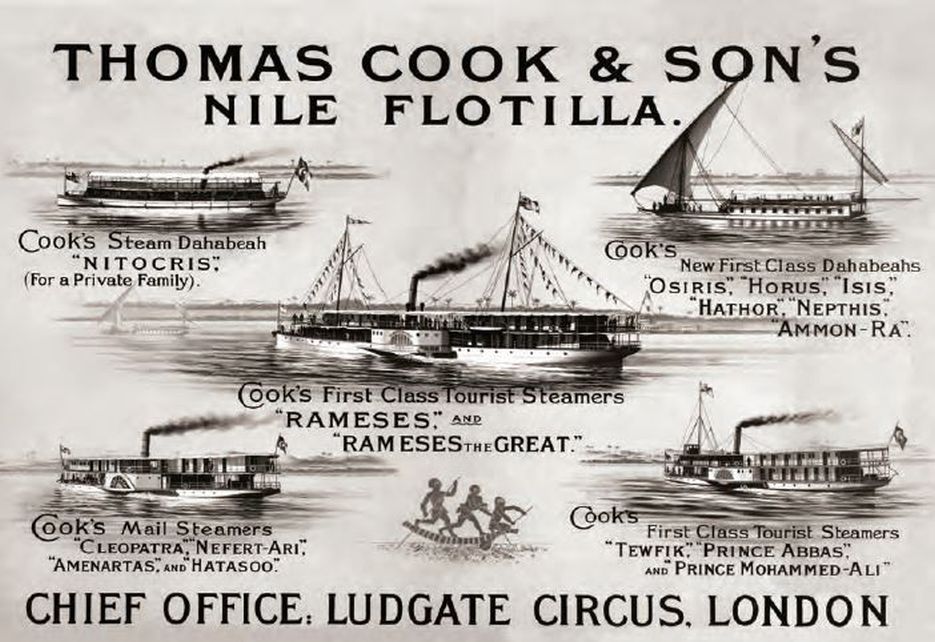
The above publicity can be dated to between 1890 and 1892
The side-wheel fleet comprised
these steamers in 1904 : (scroll down for the fleet as it stood in 1925)
For First Class passengers only :
Prince Abbas (Fairfield, 1886, 160x20 ft)
Tewfik (Fairfield, 1886, 160x20 ft), -
originally named Prince Tewfik
Rameses (France 1886, 236x30 ft)
Amasis (France, 1886, 170x20 ft) - originally named Prince Mohammed Ali
Rameses the Great (Fairfield, Glasgow, 1889, 221x30 ft)
Rameses III (J
McArthur, Paisley, engines by Bow, McLachlan,
1893, 200x28 ft)
Express
steamers
under contract to Egyptian Governement to carry mails, government and military officials
Cleopatra (J McArthur, Paisley, engines by Bow, McLachlan, 1888, 140x25 ft),
Nefertari (J
McArthur, Paisley, engines by Bow, McLachlan, 1888, 140x25 ft),
Amenartas (J
McArthur, Paisley, engines by Bow,
McLachlan, 1888, 140x25 ft)
Hatasoo (J
McArthur, Paisley, engines by Bow, McLachlan, 1890, 160x25
ft),
Smaller Steamers
often used for long private charter to the wealthy
Memnon (1904,
131x19 ft)
Serapis (125x18 ft)
Oonas
(110x18 ft)
Seti (100x18ft)
Prince Abbas, Amasis, Rameses III, Cleopatra, Nefertari, Amenartas and Hatasoo were
taken to Mespotamia in 1916 and owned by the Royal Indian Marine (who were in
charge of the British campaign in the region). Rameses III was lost to fire at Amara on the River Tigris in 1916.
Tewfik and Rameses
the Great were lost to fire in 1916 at Bouraq shipyard whilst being prepared to be sent to Mesopotamia
Paddle Steamers : 1904 Fleet
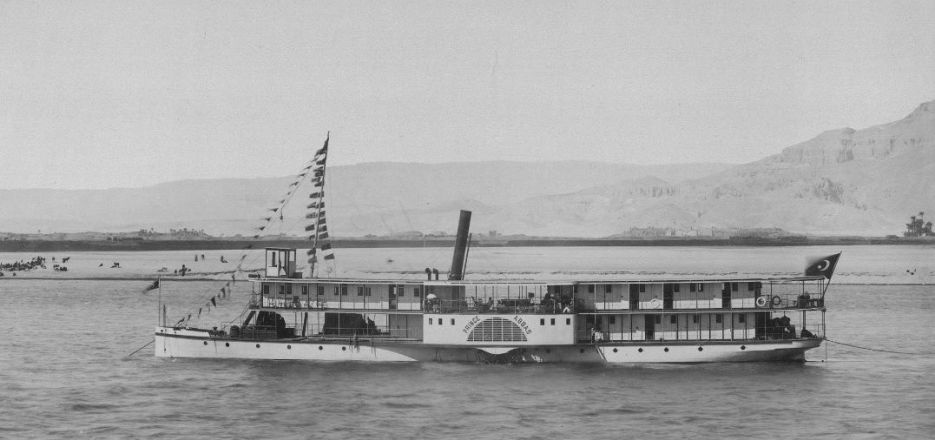
Above : Prince Abbas
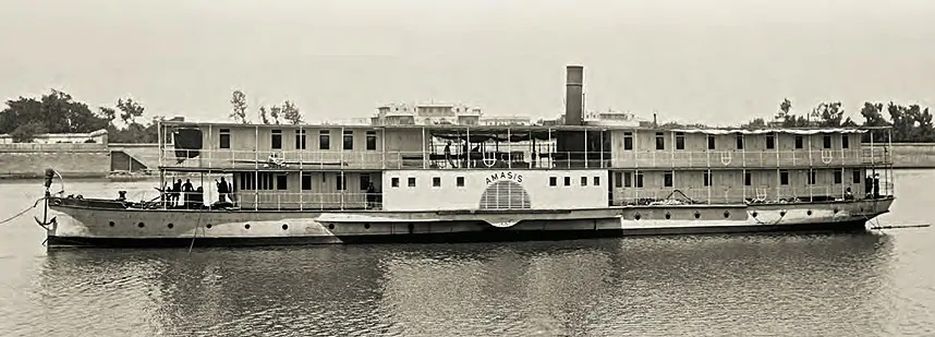
Above : Amasis
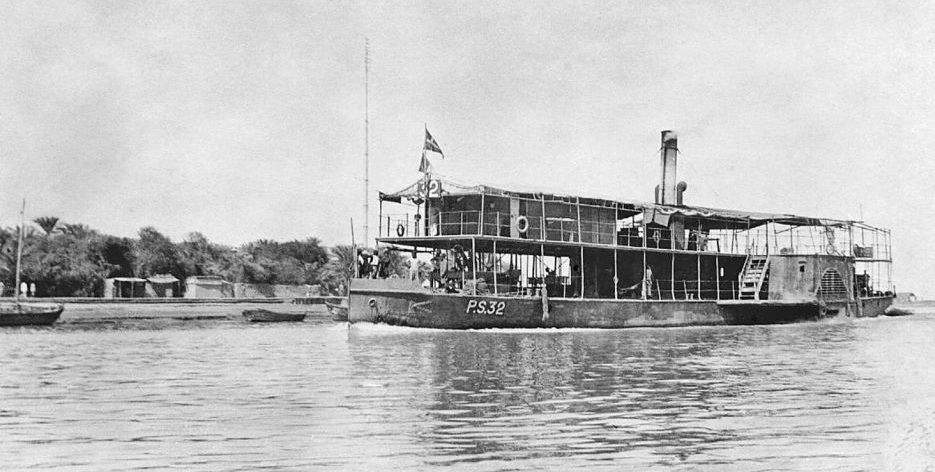
Above : Hatasoo on war service
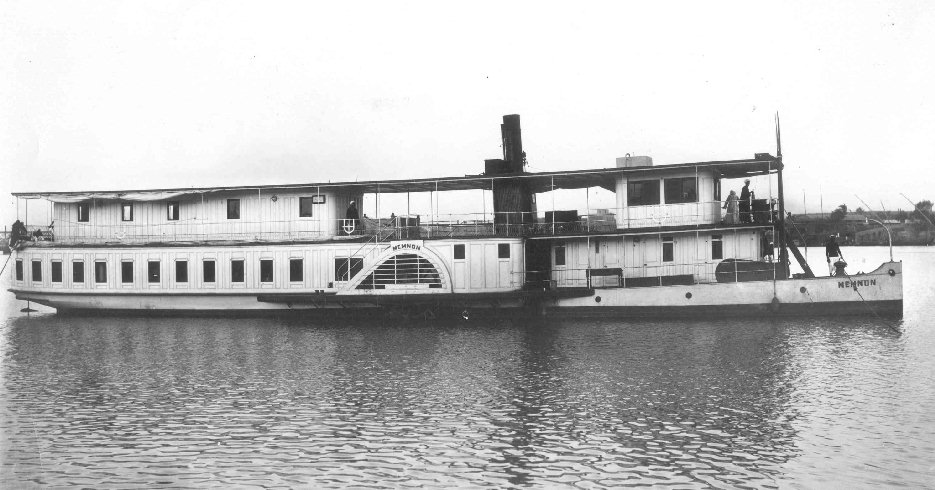
Above : Memnon
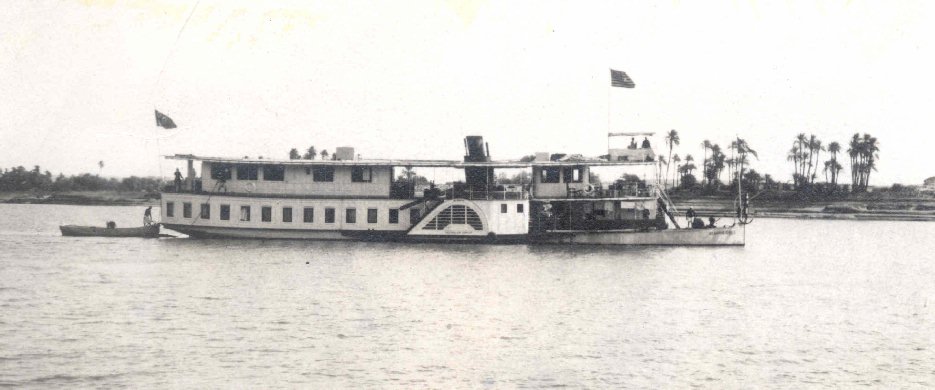
Above : Serapis.
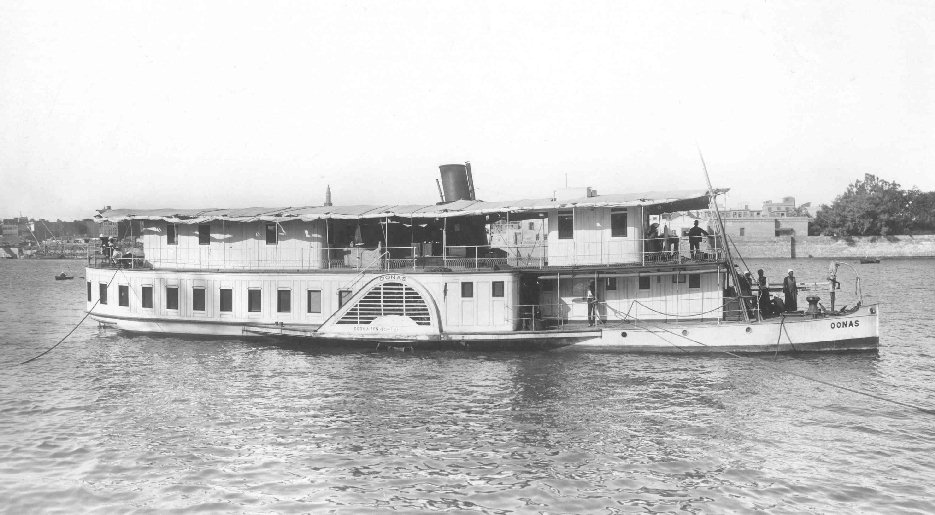
Above : Oonas.
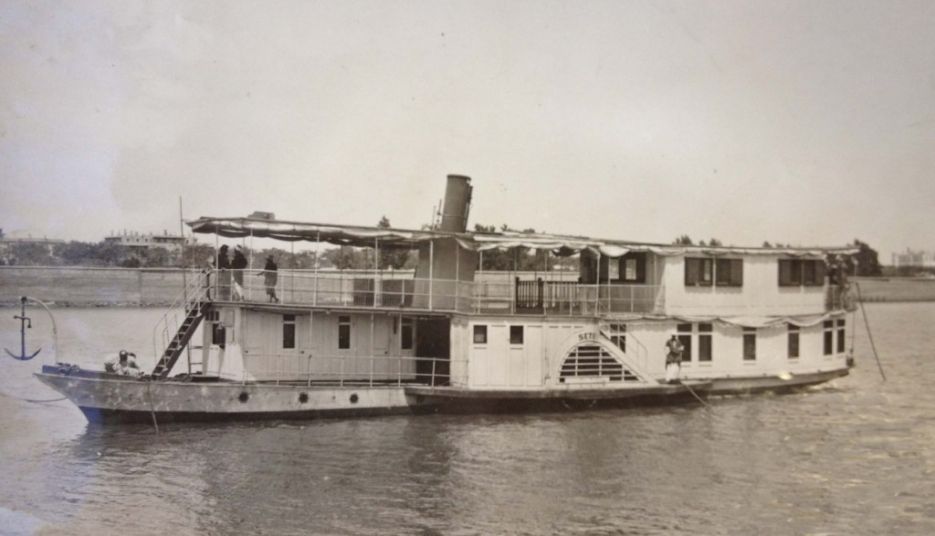
Above : Seti was used as a floating hotel at Aswan
until 1894 when Thomas Cook purchased a hotel on the shores of the Nile
The
side-wheel fleet comprised these steamers in 1925 :
Large (high-season services)
:
Egypt (Thornycroft, 1907, 230x32
ft),
Arabia (Thornycroft, 1911, 236x32 ft : 236 GRT),
Sudan (Bow, McLachlan, 1915-1921, 236x32 ft).
Small (generally
sold for group charter) :
Memnon (1904, 131x19 ft),
Chonsu (125x18 ft),
Serapis (125x18
ft),
Oonas (110x18 ft),
Seti (100x18 ft),
Sudan (in operation) and Memnon (derelict) still exist (as at January 2020)
Paddle Steamers : 1925 Fleet
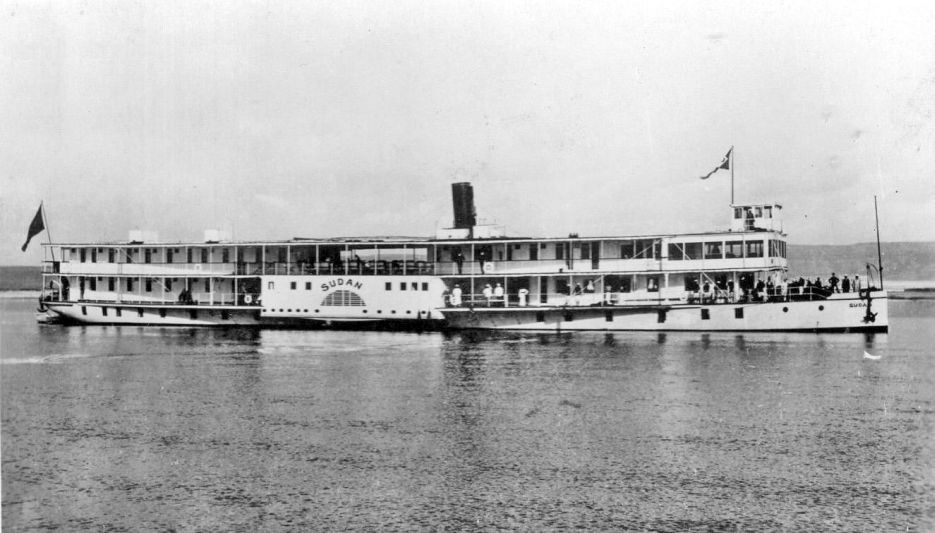
Above : Sudan

Above : Memnon.
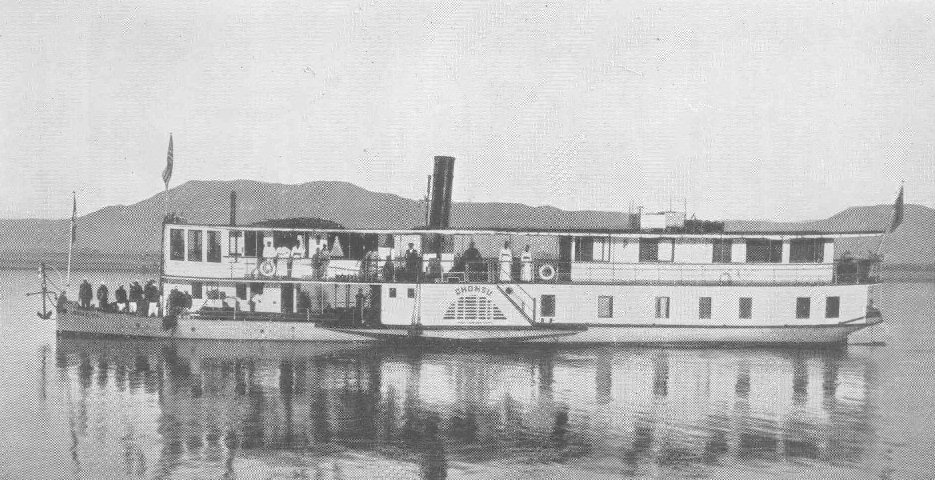
Above : Chonsu.
Sternwheelers :
Rosetta - Stern quarter wheeler
(Ferguson, Port Glasgow, 1917, 220x30 ft) former British Army Hospital Ship
"SP13", in Cooks fleet from 1922
Damietta - Stern quarter wheeler (A&J Inglis, Pointhouse,
Glasgow, 1917, 220x30 ft) former British Army Hospital Ship "HP15",
in Cooks fleet from 1921
Delta
(159x27 ft)
Thebes (150x26 ft)
Fostat
Scarab (90x17 ft)
Rosetta and Damietta were originally intended for military
hospital service on the Tigris in World War I but were in Alexandria at the
time of the armistice. It is understood from research by Alistair Deayton that
they were lengthened and converted from side-wheelers to quarter-wheelers for
Nile service.
ROYAL YACHTS (Paddle Steamers)
1849 : Sayed Pacha : Built by Caird of Greenock for Mohammed Said
1865 : El Mahrousa (converted to turbine steamer in 1905 and still in existence) and Bordein, both by Samuda Bros, London, for Khedive Ismail Pacha
1894 : Safa el Bahr : Built by A&J Inglis of Glasgow : 690 GRT : 220 x 27 ft : Triple Expansion 18, 29 and 48 in x 46 in
1926 : Kased Kheir : Built by JI Thornycroft in Southampton in kit form for King Fuad. 237 ft 9 in x 32 ft
Kased
Kheir was used to take the deposed King Farouk into exile in 1952. In
1958 it was used as a hotel annexe. The Navy Hotel - Kased Kheir
in Cairo now has a smaller modern vessel moored outside.
Quarter-Wheel Steamer Karim
The British Army, still in Egypt after World War I brought
over some paddlers - one of which became a Royal Yacht, and now a luxury river
cruiser.
A steam-fired paddler, built in 1917. She is understood to have been built to
a design of the Lytham Shipbuilding & Engineering Co for use
on the Rivers Tigris and Eurphrates in Baghdad for the British Army.
A number of vessels were sent to Iraq, but possibly six (one of
which which became Karim), went for use in Egypt instead. Soon afterwards
she was used by the then Sultan, later King Fuad
I of Egypt and later by his son and, after the republican revolution, state presidents.
She has been in regular passenger service for public cruises
since refurbishment in 1991. The 45.8
metre long vessel has 15 luxury cabins and is equipped for 30
passengers. Her normal schedule is for 7-night cruises from Luxor to
the Aswan Dam at Lake Nasser and is operated by local company Spring Tours.
She has stern-placed side wheels, the so-called "quarter-wheel"
arrangement, which can be operated independently and are driven
by two compound engines.
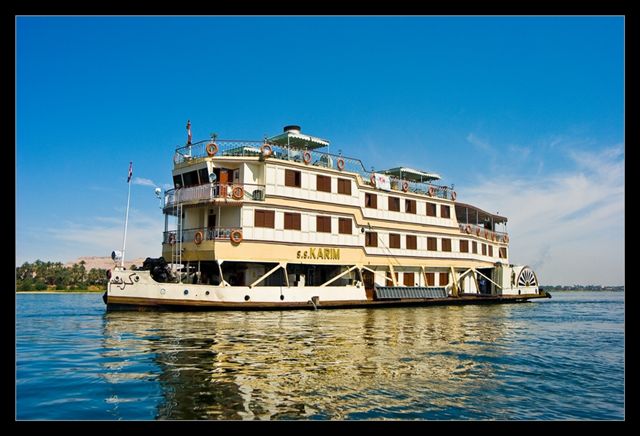
Photo kindly supplied by Mr Morsi Shehata, General
Manager of Spring Tours
Return
to
Historical Database
Egypt












